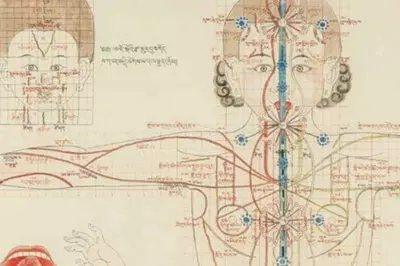Tibetan Medicine

Tibetan meditation
Tibetan medicine emphasizes the connection between mind, behavior, and body. You may be amazed at how unruly your mind is when you try to sit quietly and observe your thoughts. Tibetan meditation is designed to tame your monkey mind and help it become a tool that you can use to create health and happiness. Meditation is like training your mental muscle. Your mind improves with practice.
Become familiar with your mind
Meditation is an essential part of Tibetan medicine. The purpose is to investigate the nature of reality, tame the “monkey mind,” and transform the mind into a tool to create health and happiness.
You have many options for taming your mind. For example, you can meditate while sitting, walking, lying down, dancing, or even listening to music. You may feel less distracted if you sit while meditating. Just start with a brief two-minute meditation every hour or so to calm and focus your mind.
Tibetan meditations you can use
These three Tibetan meditations will help you to let go of negativity and develop lovingkindness and compassion toward yourself, others, and the world around you. Lovingkindness and compassion enhance the immune system, open the heart, and promote balance. Doing these meditations regularly will promote your health and happiness.
Meditation on Compassion
- Make yourself comfortable sitting, standing, walking, or lying down.
- Straighten your back, relax your body, and breathe deeply; shift your focus from external distractions to your mind.
- Engage in circular breathing throughout the meditation: Breathe slowly and deeply through your nose, from your abdomen, with your in-breath the same length as out-breath, and no break in-between.
- Chant this Tibetan mantra repeatedly, evenly, and quietly with the intention of developing compassion:
Om Mani Padme Hum
Here is how you pronounce this mantra: (h)ome, man ee, pad mee, hoom.
This mantra means the “jewel (compassion) in the center of the lotus (your heart).” Chanting this mantra can help you to let go of negativity and fill your heart with compassion and lovingkindness. Regular, systematic chanting of this mantra promotes physical, mental, and spiritual health. Some people believe that chanting this mantra for a person who is dying helps the person to let go and die peacefully.
Tibetan Prostrations
Tibetan prostrations help to harmonize mind and body. They are a Tibetan version of “Sun Salutations,” a series of popular yoga poses.
- Stand tall like a mountain, with your hands in prayer pose in front of your chest at the level of your heart. In yoga, this posture is called Mountain Pose.
- Relax your body, lower your eyelids, and breathe deeply; shift your focus from external distractions to your mind.
- Engage in circular breathing throughout this meditation: Breathe slowly and deeply through your nose, from your abdomen, with your in-breath the same length as out-breath, and no break in-between.
- Keeping your hands together in prayer pose, place your hands at the crown of your head, then at your forehead, then at your throat, and then at the level of your heart.
- Kneel on the floor, with your hands flat on floor, and touch your forehead to the floor. Or, for a full-length prostration, kneel on the floor and then lie flat on the floor, forehead touching floor, arms outstretched, and hands flat on floor.
- Stand up, return to Mountain Pose, and bring your attention back to circular breathing.
- Do at least three prostrations.
- Stand up and return to Mountain Pose; bring your attention back to circular breathing.
- Open your eyes; continue circular breathing, mindfulness, and centeredness throughout the day.
Tonglen Meditation
“Breathe in suffering and breathe out compassion”
- Make yourself comfortable sitting, standing, walking, or lying down.
- Straighten your back, relax your body, and breathe deeply; shift your focus from external distractions to your mind.
- Engage in circular breathing throughout this meditation: Breathe slowly and deeply through your nostrils, from your abdomen, with the in-breath the same length as the out-breath, and without a pause in between the in-breath and out-breath.
- Do Tonglen for yourself: As you breathe in, let your greed, anger, jealousy, fear, attachment, confusion, and other negative thinking come to the surface. On your out-breath, breathe out this negative thinking, and fill the empty space with compassion.
- Do Tonglen for someone you love: Breathe in the suffering of someone you love, and breathe out compassion to the person. Realize that your loved one wants to be happy, but is suffering instead. Open your heart to your loved one.
- Do Tonglen for someone about whom you feel neutral: Breathe in the suffering of someone about whom you feel neutral (for example, a clerk in a store), and breathe out compassion to this person. Realize that the individual wants to be happy but is suffering instead. Open your heart to the person.
- Do Tonglen for someone you dislike: Breathe in the suffering of someone you think has hurt you, and breathe out compassion to the person. Realize that the individual, like you and everyone else, wants to be happy. Because of negative thinking, the person makes harmful choices that lead to suffering. If you increase that suffering, the person may behave even worse. You are best off developing compassion so you can think clearly about how to deal with the individual in a manner that brings back good consequences, not bad ones (karma). Open your heart to the person.
- Do Tonglen for the world: Breathe in the suffering of the world, and breathe out compassion to the world. Realize that everyone in the world wants to be happy, but too often makes unhealthy choices that lead to suffering instead. By developing universal compassion, you will take steps to help relieve this suffering. Open your heart to the world.
- Purification: At the end of your meditation, visualize the suffering you breathed in as black smoke. You must let go of this black smoke, or it could increase your own suffering. Breathe out this black smoke completely. Then fill your heart and your whole being with compassion toward yourself, everyone else, and the world.
This meditation uses the breath to transform negativity into compassion for yourself and others. By doing Tonglen Meditation on a regular basis, you will let go of negativity, open your heart, and develop clear thinking that leads to healthy lifestyle choices.
Breath meditation
This guided meditation uses the breath as the object of attention.
Meditation Exercise
Sit comfortably with your feet on the floor.
Click the link below to start the audio, then close your eyes and listen. If you find your mind wandering gently bring it back and start again.
If you prefer you can download the MP3 file to play in a relaxing environment. You will need to unzip this file once downloaded.
Compassion meditation
Try a 20-minute compassionate body scan exercise.
Forgiveness meditation
A guided meditation to practice forgiveness.
Guided Forgiveness Meditation
This guided forgiveness practice has three steps: We begin with those whom we have caused harm, intentionally or unintentionally. Next we turn our attention to those who have similarly caused us harm, intentionally or unintentionally. And, finally, we turn our attention to self-forgiveness, for ways we may have harmed ourselves, intentionally or unintentionally. You can repeat this process with the same or different people as often as you wish.
Article Updated: May, 2020




